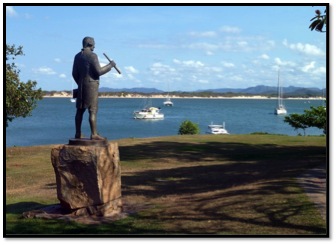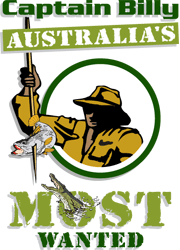

Cape York - it’s pivotal role in Australia’s colourful History We have not long returned from 16 days of four wheel driving to the northernmost point of the continent of Australia. I bet you’re just itching to know what the highlights were. Was it the scenery? This is a land of great contrasts. Lush tropical rain forests gave way to barren red escarpments. Craggy rock formations and termite mounds, of all shapes and sizes, punctuated the landscape. Creeks and/or rivers lurked around every corner. While some featured waterfalls, it was great to sit at their base and let the water pound down on us, others were deserts-like; we deflated the landcruiser’s tyres to guarantee safe passage. Was it the 4WD experience? We were amazed at the roads and waterways Tom, our experienced driver, was able to negotiate in the landcruiser. We completed the legendary “Old Telegraph Road” and the “Frenchman’s Track”. At one stage on this road, which looks like it doubles as a drain in the wet season, we took 4+ hours to travel 30klms. I have now learned that you can’t call yourself a four wheel driver until you have successfully conquered Gunshot Creek. Go to “You Tube” and type in “Gunshot Creek” and you’ll get some idea of this monster of a crossing. Was it the camping? We loved it; particularly the really remote sites where there wasn’t another human being within cooee. Our only neighbours were kangaroos, wallabies and kookaburras. Housed in a “Kimberley Kamper”, a very comfortable queen sized bed welcomed us each night. Every morning we were woken by the sounds of the Australian bush. Going without a shower for a few days was no real imposition for me but, the bride had withdrawal symptoms being unable to plug in her hair-dryer for 16 days. She still looked beautiful. Was it standing at the northern tip of Australia? Having been to Cape Byron, the eastern most point of this great land; Wilson’s Promontory in the south with its vista of Bass Strait and Cape Leeuwin [the south west corner of WA] where the Great Southern Ocean and the Indian Ocean collide it was exciting to stand on the northernmost point of the continent [See the picture below]. I have a thing about getting to the very edge of islands/countries. 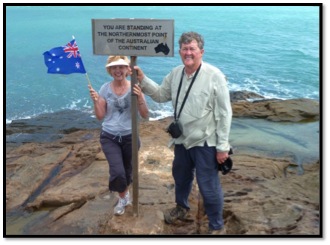 No doubt all these features combined to make this journey an unforgettable experience however, it was something much less tangible that grabbed my attention - the pivotal role this part of Australia has played in our history. From the moment we arrived in Cooktown it was as if we stepped back in time; the place reeked with history. There were reminders everywhere that on the 11th June 1770 Captain James Cook’s ship, the Endeavour, ran aground on the Great Barrier Reef. His voyage was delayed seven weeks while repairs were carried out on a beach near where Cooktown stands today. Once repairs were completed the voyage continued; sailing through Torres Strait [passed where we are standing in the photo only 241 years later] and on 22nd August 1770 he landed at Possession Island, where he claimed the entire eastern coastline as British Territory. Later in our trip we flew over Possession Is. and had a birds-eye view of the cairn commemorating this momentous occasion. Captain Cook is universally recognised as one of the great sailor/navigators of all time. Cook’s charts of the treacherous waters of the Great Barrier Reef are still accurate enough to be used today. Whereas Cook wasn’t the first European to set foot on the shores of Australia he was the first to take possession of this Great South Land.
A statue of Captain Cook surveying the foreshore of Cooktown. During our 16 days on Cape York we saw many “cairns” [such as the one pictured below] erected in tribute to the courage and achievements of Edmund Besley Court Kennedy for his role in unlocking the mysteries of this area. On the 29th April 1848 Kennedy and his men sailed out of Sydney Harbour for Rockingham Bay on the north eastern coastline. Once they landed they set out to try and find an overland route from the Gulf of Carpentaria to Sydney. The party encountered terrible terrain and after two months had only gone 30klms. We thought 30klms in four hours was a bit much and we were sitting in a vehicle. It was decided to split into two groups; one group stayed behind while Kennedy and a young aboriginal man, Jackey Jackey [aka Jacky Jacky], went on to find the supply ship. Kennedy was killed by aborigines near Cape York; Jackey Jackey was the only survivor. 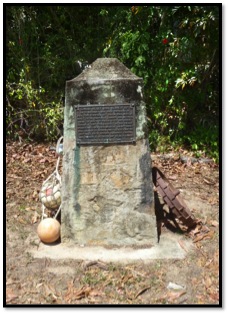 Honouring his memory, Jacky Jacky Airfield [aka Higgins Field during World War II] is located about 8klms south of Bamaga. It was constructed by the American Forces during World War II and played an integral role in the Battle for the Coral Sea and the Japanese push into New Guinea. Around the airstrip there are stark reminders of war and the havoc it brings. Plane wrecks still lay where they crashed or where they were dragged off the air strip to allow the next bomber to take off. Many square kilometres of bushland are dotted with the rusty remains of 44 gallon petrol drums. [See the photo]. The rust and the red soil conspire to paint an eerie scene. 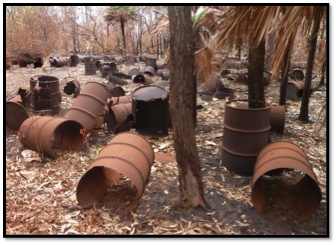 Time and Space, let alone the risk of boring you, have confined me to mentioning only a few of the brave souls who ventured into this hostile environment. These men and women helped to shape who and what we are today. Whereas I had some knowledge of explorers such as Cook and Kennedy, courtesy of my previous life as a primary school teacher, I had no knowledge whatsoever of this area’s involvement in the Second World War. This got me to thinking - Does the average Aussie give a damn about his/her history? I would be so bold as to say, most Australians know more about American History than they do about their own. Admittedly American History lessons are subliminal thanks to television and movies. Who hasn’t heard of George Washington, Davy Crockett or, for that matter, John F Kennedy? If asked the question - Should our educators place more emphasis on our heritage? My answer would be a resounding YES. Thought for the Month - Learn from yesterday, live for today and hope for tomorrow. |
